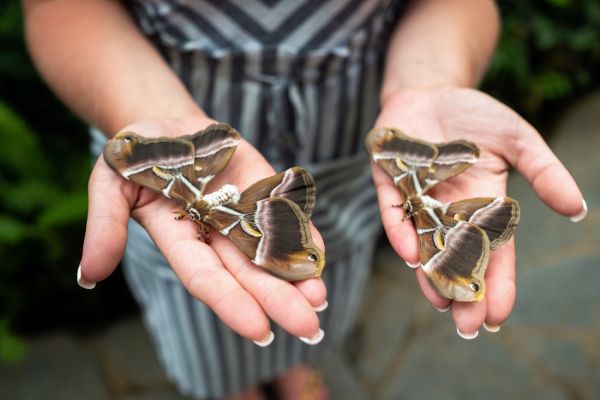
In Toronto, moths pose a significant problem to both homeowners and businesses, as they have the potential to cause damage to clothing, fabrics, and food supplies. Knowing how to effectively manage these pests is crucial for protecting your property.
In this comprehensive guide, we will delve into the most common moth species found in the city of Toronto, identify key signs of infestation, and provide practical control measures that will help you maintain a moth-free environment.
Moths can be a real pain in the neck. If you tried to get rid of them yourself but still find that they just keep coming back your best bet is to seek professional exterminator services that specialize in moth removal and control. Our team of experienced exterminators knows exactly how to deal with these persistent insects using safe and effective methods. Whether you’re dealing with clothes moths or pantry moths, our technicians have the knowledge needed to rid your home or business of these destructive creatures. From identifying their eggs to implementing targeted treatments, our goal is to solve the problem as fast as possible. Don’t let moths take over your space – contact us today for the best moth extermination services in Toronto.
Common Moth Species in Toronto
Toronto is home to a fair amount of moth species, each with distinct characteristics and behaviors. Here are some of the most frequently encountered types:
| Species | Description | Potential Damage |
|---|---|---|
| Clothes Moth | Tiny, golden-brown moths have a keen attraction to natural fibers. | High – Can wreak havoc on clothing, upholstery, and textiles, leaving them ruined. |
| Indian Meal Moth | Brown moths with a distinctive reddish band on their wings; often found in food storage areas. | Moderate – Can invade grains, dried fruits, and other pantry staples with alarming ease. |
| Webbing Clothes Moth | Unlike the clothes moth, this pest weaves intricate silk webs wherever it invades. | High – Infamous for putting holes in wool, silk, and other natural fibers. |
Differences Between Butterflies and Moths
Not to get too complicated, butterflies form a monophyletic group while moths do not. In simpler terms it just means that they evolved differently. Moths are much older in the evolutionary timeline and although they have very similar charachteristics to butterflies some distinguishing features include the following:
1. Physical Differences
| Feature | Butterflies | Moths |
|---|---|---|
| Antennae | Thin and club-shaped at the ends | Feathery or thread-like, without clubs |
| Wings at Rest | Hold wings vertically over their bodies | Spread wings flat or fold them tent-like over their bodies |
| Body Shape | Slender and smooth-bodied | Fatter, often fuzzy due to dense scales |
| Coloration | Usually brightly colored | Often dull, brown, gray, or camouflage-colored |
2. Behavioral Differences
| Feature | Butterflies | Moths |
|---|---|---|
| Activity Time | Active during the day (diurnal) | Active at night (nocturnal) |
| Flying Patterns | More direct and gliding flight | Tends to flutter more erratically |
| Attracted to Light? | No | Yes—moths are drawn to artificial light (phototaxis) |
3. Life Cycle Differences
| Feature | Butterflies | Moths |
|---|---|---|
| Cocoon vs. Chrysalis | Transform inside a chrysalis (a hard, smooth pupa) | Form a cocoon (a silk-covered casing) |
| Larval Appearance | Caterpillars are usually smooth-bodied | Many moth caterpillars have hairy or spiny bodies |
Recognizing Signs of a Moth Infestation
Early detection of a moth infestation can prevent costly damage. Here are some key indicators to look for:
- Adult Moths: Spotting adult moths flying around your home, especially near light sources.
- Larvae: Finding small, caterpillar-like larvae in closets or food storage areas.
- Fabric Damage: Noticing holes or fraying in clothing, carpets, or upholstery.
- Silk Webbing: Observing silk webbing in corners or on fabrics, indicating larvae activity.
Effective Control Measures
When faced with a moth problem, prompt action is crucial. Here are some effective strategies for controlling moth populations:
- Professional Pest Control: Engaging a pest control expert can provide targeted treatments that are both safe and effective.
- Insecticides: Applying insecticides specifically formulated for moths, ensuring to follow the manufacturer’s guidelines.
- Pheromone Traps: Utilizing pheromone traps can help monitor and reduce adult moth populations effectively.
Understanding Moth Behavior and Lifecycle
To effectively manage moth infestations, it’s essential to understand their behavior and lifecycle. Moths undergo a complete metamorphosis, which includes four stages: egg, larva (caterpillar), pupa, and adult. Here’s a brief overview of each stage:
| Stage | Description | Duration |
|---|---|---|
| Egg | In secret nooks near abundant food sources, female moths stealthily deposit their eggs. | 3-10 days |
| Larva | Hungry hatchlings devour fabrics and food, leaving a trail of signs. | 2-3 months |
| Pupa | Larvae weave cocoons and undergo a metamorphosis in the pupal stage. | 1-2 weeks |
| Adult | Full grown, eager to mate and lay eggs. | 1-2 weeks |
Pros and Cons of Different Moth Control Methods
When considering how to tackle a moth problem, it’s important to weigh the pros and cons of various control methods:
| Method | Pros | Cons |
|---|---|---|
| Professional Extermination | Effective and thorough; tailored solutions; saves time. | Can be costly; requires scheduling. |
| Insecticides | Widely available; can be effective against various pests. | May require multiple applications; potential health risks; environmental concerns. |
| Pheromone Traps | Non-toxic; easy to use; helps monitor populations. | Limited effectiveness for large infestations; may not eliminate all moths. |
| Natural Remedies | Safe for pets and children; environmentally friendly. | May be less effective; requires consistent application. |
Key Takeaways for Moth Control
Here are the top points to remember when dealing with moth infestations:
- Early Detection is Key: Regularly inspecting your home for signs of moths is crucial for catching infestations early, which can save you significant time, effort, and money
- Choose the Right Method: When considering the most effective control methods for your pest infestation, it is crucial to weigh the advantages and disadvantages of each option. By carefully evaluating the pros and cons of various extermination techniques, you can determine which approach will best suit your specific situation.
- Prevention is Essential: Take proactive steps to minimize the risk of future infestations. By implementing preventive measures, you can significantly reduce the chances of suffering through another infestation. To safeguard against potential infestations, it is essential to regularly inspect and treat areas where moths take refuge, such as clothing storage spaces or food storage areas. By being vigilant and taking action early on, you can prevent damage caused by caterpillars or larvae that feed on fabrics or pantry items.
- Seek Professional Help: If the infestation is severe, don’t hesitate to contact a pest control expert for assistance. Call GTA Toronto Pest Control for a free quote.
Author Bio: Naeem Choudhry
Pest Control Expert
Naeem Choudhry is a seasoned pest control specialist with over 20 years of hands-on experience. Based in Toronto, he stays up to date with the latest industry best practices and is an active member of the National Pest Management Association of Canada.
Known for his practical tips and outstanding customer service, Naeem frequently hosts community workshops where he educates the public on pest identification, behaviour, and effective control methods. When he’s not out in the field, he shares his expertise through articles, educational events, and community outreach initiatives.
For more insights, follow him on x.com.
